Lyons W.C. (ed.). Standard handbook of petroleum and natural gas engineering.2001- Volume 1
Подождите немного. Документ загружается.

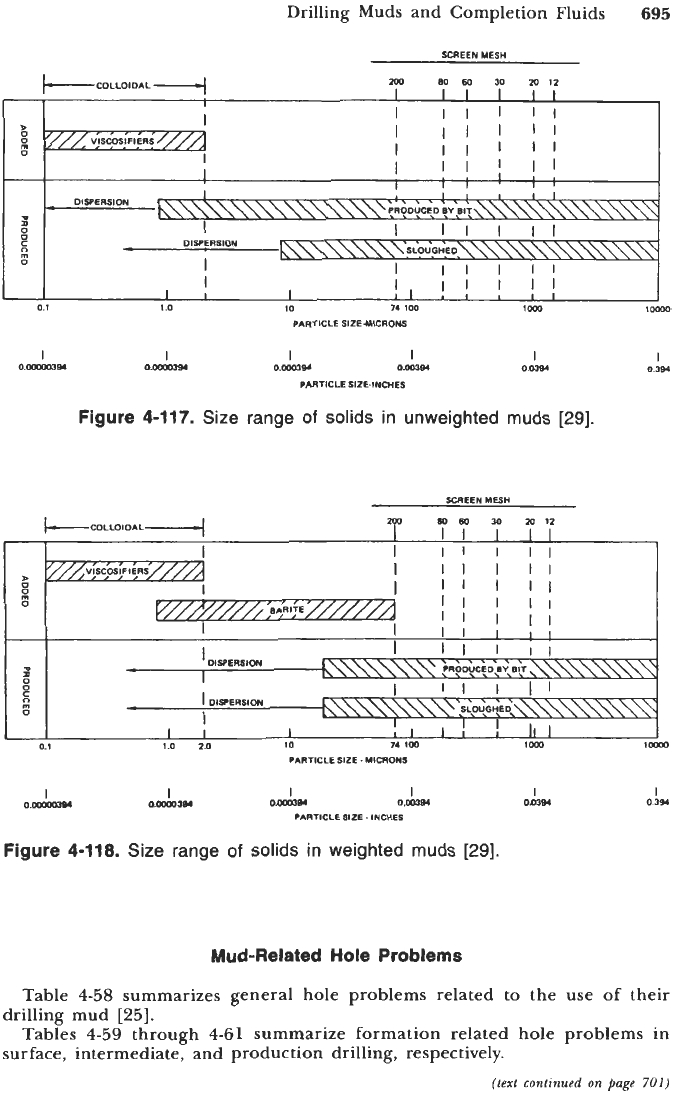
Drilling Muds and Completion Fluids
695
SCREEN
MESH
DISPERSION
DISPERSION
m
I
I
t
I
I
0.1
1.0
10
7.
700
1wO
1mo
PARTICLE SlZEUlCRONS
I
I
I
I
I
0.-(Y
Omormol
omm
0110381
0.W
PARTICLE
SlZE.lNCHES
I
0.394
Figure
4-117.
Size range
of
solids in unweighted muds
[29].
SCREEN
MESH
i.0
2.0
10
74
1w
PARTICLE SIZE. MICRONS
I
I
oms
0.3s
I
I
0-
0110381
PARTICLE
SIZE.
INCHES
I
QQOOOSU
I
0-
Figure
4-118.
Size range
of
solids in weighted muds
[29].
Mud-Related
Hole
Problems
Table
4-58
summarizes general hole problems related to the use
of
their
Tables
4-59
through
4-61
summarize formation related hole problems in
drilling mud
[25].
surface, intermediate, and production drilling, respectively.
(text
continued
on
page
701)

696
Drilling and Well Completions
Figure
4-119.
Practical limits on solids content in freshwater-base mud
[26].
(Courtesy Baroid Drilling Fluids, Inc.)
Figure
4-120.
Practical limits on solids content in saltwater mud
(75,000
ppm
chlorides)
[26].
(Courtesy Baroid Drilling Fluids, Inc.)
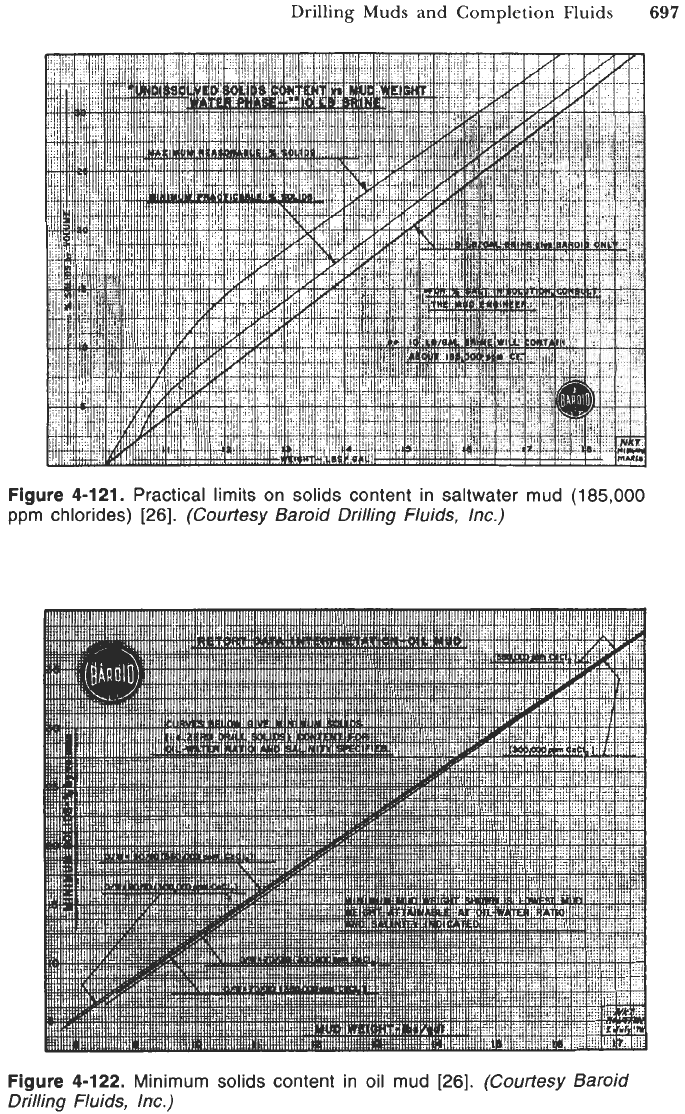
Drilling Muds and Completion Fluids
697
Figure 4-1 21.
Practical limits on solids content in saltwater mud
(1
85,000
ppm chlorides)
[26].
(Courtesy
Baroid Drilling Fluids, Inc.)
Figure 4-122.
Minimum solids content in oil mud
[26].
(Courtesy Baroid
Drilling Fluids, Irrc.)
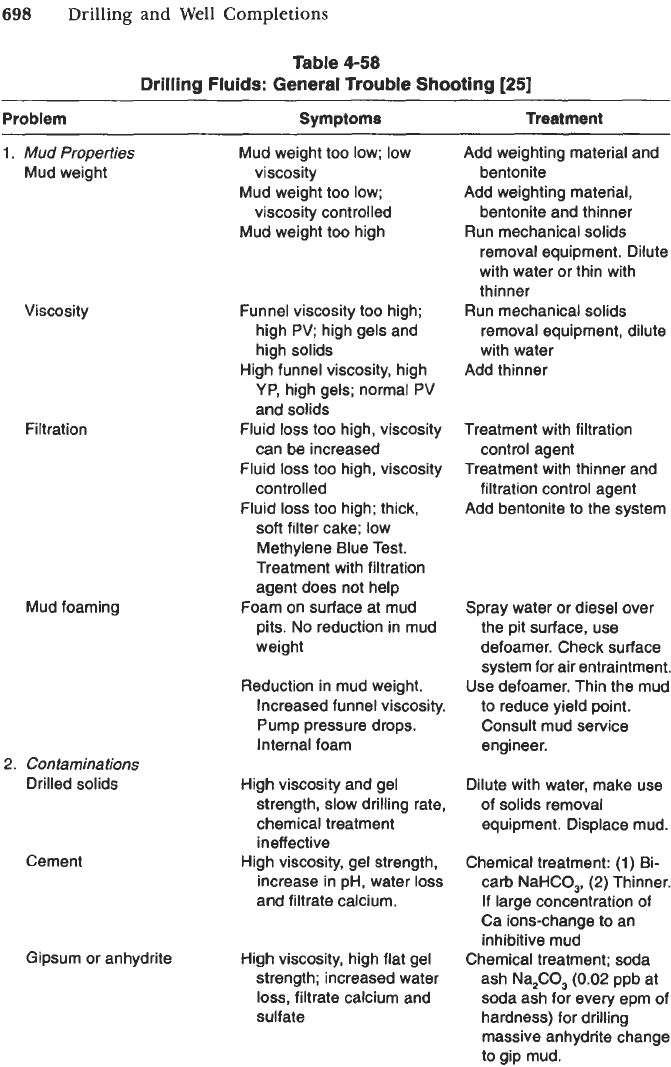
698
Drilling and Well Completions
Table
4-58
Drilling
Fluids:
General Trouble Shooting
[25]
Problem Symptoms Treatment
1.
Mud
Properties
Mud weight too low; low
Mud weight too low;
Mud weight too high
Mud weight viscosity
viscosity controlled
Viscosity
Filtration
Mud foaming
2.
Contaminations
Drilled solids
Cement
Funnel viscosity too high;
high PV; high gels and
high solids
High funnel viscosity, high
YP, high gels; normal
PV
and solids
Fluid loss too high, viscosity
can be increased
Fluid
loss too high, viscosity
controlled
Fluid
loss too high; thick,
soft
filter cake; low
Methylene Blue Test.
Treatment with filtration
agent does not help
Foam
on
surface at mud
pits. No reduction in mud
weight
Reduction in mud weight.
Increased funnel viscosity.
Pump pressure drops.
Internal foam
High viscosity and gel
strength, slow drilling rate,
chemical treatment
ineffective
High viscosity, gel strength,
increase in pH, water
loss
and filtrate calcium.
Gipsum or anhydrite
High viscosity, high flat gel
strength; increased water
loss,
filtrate calcium and
sulfate
Add weighting material and
bentonite
Add weighting material,
bentonite and thinner
Run mechanical solids
removal equipment. Dilute
with water
or
thin with
thinner
removal equipment, dilute
with water
Add thinner
Run mechanical solids
Treatment with filtration
control agent
Treatment with thinner and
filtration control agent
Add bentonite
to
the system
Spray water or diesel over
the pit surface, use
defoamer. Check surface
system for air entraintment.
Use defoamer. Thin the mud
to reduce yield point.
Consult mud service
engineer.
Dilute with water, make use
of solids removal
equipment. Displace mud.
Chemical treatment:
(1)
Bi-
carb NaHCO,,
(2)
Thinner.
If large concentration
of
Ca ionschange to
an
inhibitive mud
Chemical treatment; soda
ash Na,CO,
(0.02
ppb at
soda ash for every epm of
hardness) for drilling
massive anhydrite change
to gip mud.
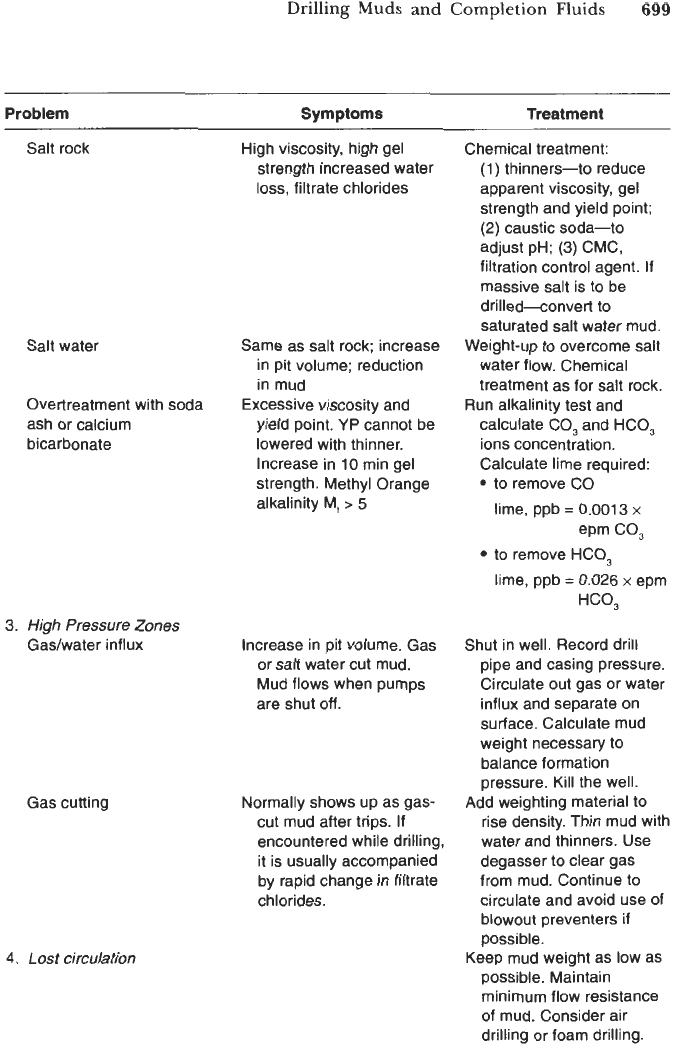
Drilling Muds and Completion Fluids
699
Problem Symptoms Treatment
Salt rock
High viscosity, high gel
strength increased water
loss, filtrate chlorides
Salt water
Same as salt rock; increase
in pit volume; reduction
in mud
yield point.
YP
cannot be
Increase in
10
min gel
strength. Methyl Orange
alkalinity M,
> 5
Overtreatment with soda
ash or calcium
bicarbonate lowered with thinner.
Excessive viscosity and
3.
High
Pressure Zones
Gaslwater influx
Gas cutting
4.
Lost
circulation
Increase in pit volume. Gas
or salt water cut mud.
Mud flows when pumps
are shut
off.
Normally shows up as gas-
cut mud after trips.
If
encountered while drilling,
it is usually accompanied
by rapid change in filtrate
chlorides.
Chemical treatment:
(1)
thinners-to reduce
apparent viscosity, gel
strength and yield point;
(2)
caustic soda-to
adjust pH;
(3)
CMC,
filtration control agent.
If
massive salt is to be
drilled-convert to
saturated salt water mud.
Weight-up
to
overcome salt
water flow. Chemical
treatment as for salt rock.
Run alkalinity test and
calculate CO, and HCO,
ions concentration.
Calculate lime required:
to remove
CO
lime, ppb
=
0.001
3
x
epm CO,
to remove HCO,
lime, ppb
=
0.026
x
epm
HCO,
Shut in well. Record drill
pipe and casing pressure.
Circulate
out
gas or water
influx and separate on
surface. Calculate mud
weight necessary to
balance formation
pressure. Kill the well.
Add weighting material
to
rise density. Thin mud with
water and thinners. Use
degasser
to
clear gas
from mud. Continue to
circulate and avoid use of
blowout preventers
if
possible.
Keep mud weight as low as
possible. Maintain
minimum flow resistance
of mud. Consider air
drilling or foam drilling.
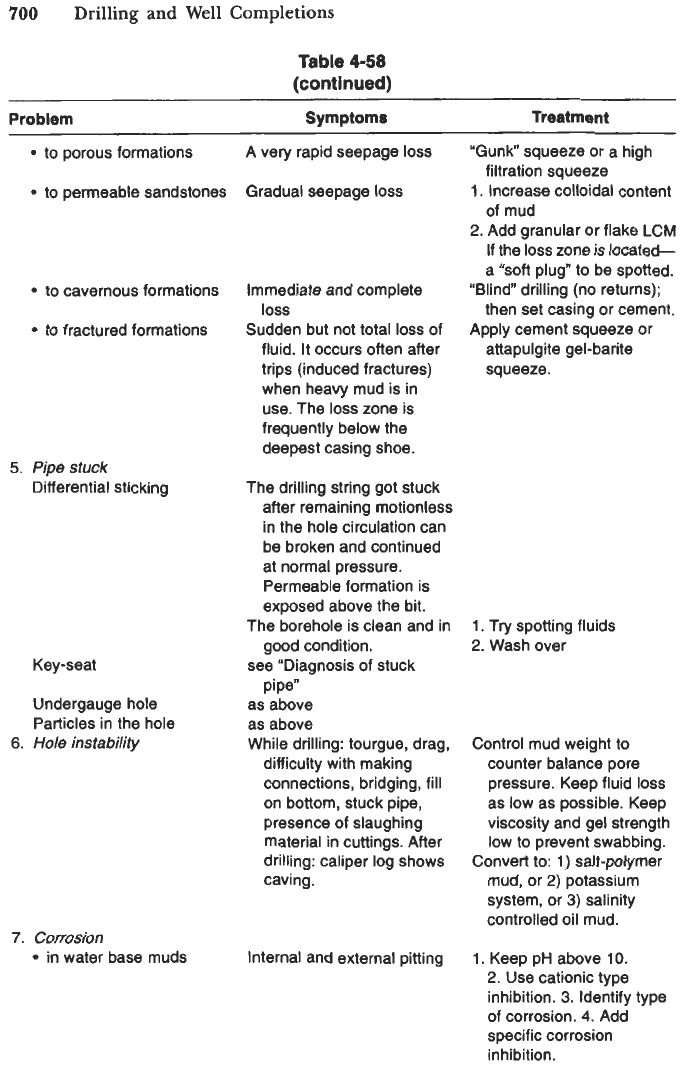
700
Drilling and Well Completions
Table 4-58
(continued)
Problem Symptoms Treatment
to porous formations A very rapid seepage
loss
to permeable sandstones Gradual seepage
loss
to cavernous formations
to
fractured formations
Immediate and complete
loss
Sudden but not total
loss
of
fluid. It occurs often after
trips (induced fractures)
when heavy mud is in
use. The
loss
zone is
frequently below the
deepest casing shoe.
5.
Pipe
stuck
Differential sticking
Key-seat
Undergauge hole
Particles in the hole
6.
Hole
instability
7.
Corrosion
in water base muds
The drilling string got stuck
after remaining motionless
in the hole circulation can
be broken and continued
at normal pressure.
Permeable formation is
exposed above the bit.
The borehole is clean and in
good condition.
see “Diagnosis of stuck
pipe”
as above
as above
While drilling: tourgue, drag,
difficulty with making
connections, bridging, fill
on bottom, stuck pipe,
presence of slaughing
material in cuttings. After
drilling: caliper log shows
caving.
Internal and external pitting
“Gunk” squeeze or a high
filtration squeeze
1.
Increase colloidal content
of mud
2.
Add granular or flake LCM
If the
loss
zone is locate+
a
“sofl
plug” to be spotted.
“Blind drilling (no returns);
then set casing
or
cement.
Apply cement squeeze or
attapulgite gel-barite
squeeze.
1.
Try spotting fluids
2.
Wash over
Control mud weight to
counter balance pore
pressure. Keep fluid
loss
as low as possible. Keep
viscosity and gel strength
low to prevent swabbing.
Convert to:
1)
salt-polymer
mud, or
2)
potassium
system, or
3)
salinity
controlled oil mud.
1.
Keep pH above
10.
2.
Use cationic type
inhibition.
3.
Identify type
of corrosion.
4.
Add
specific corrosion
inhibition.
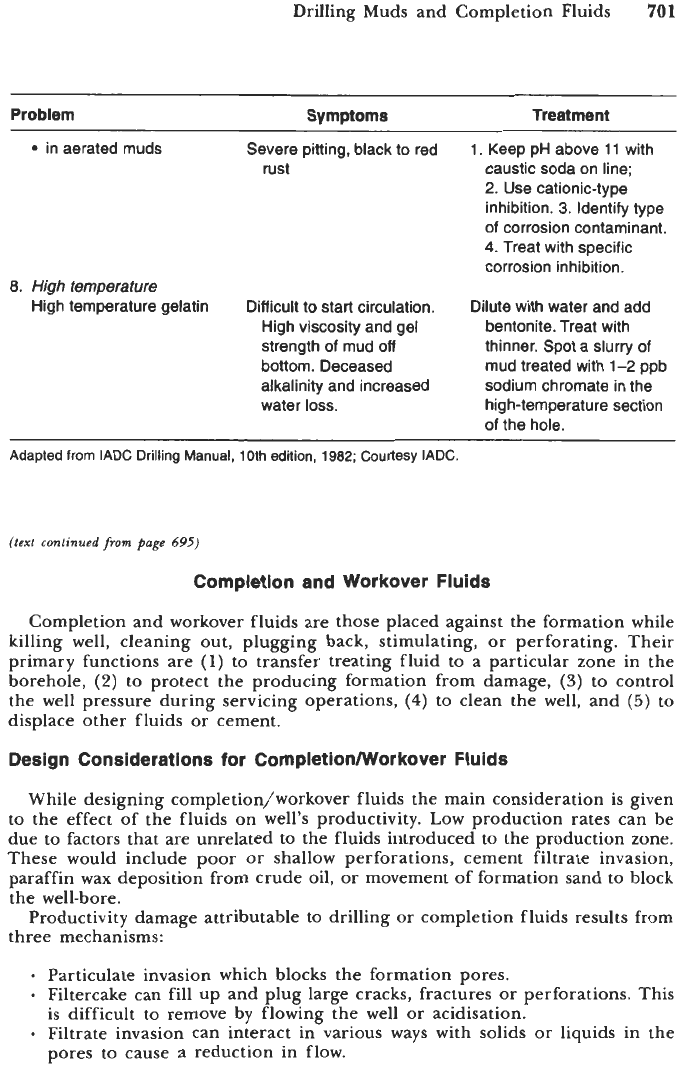
Drilling Muds and Completion Fluids
701
Problem
Symptoms Treatment
in aerated muds
Severe pitting, black to red
1. Keep pH above 11 with
rust caustic soda on line;
2. Use cationic-type
inhibition.
3.
Identify type
of
corrosion contaminant.
4.
Treat with specific
corrosion inhibition.
Difficult to start circulation. Dilute with water and add
High viscosity and gel bentonite. Treat with
strength
of
mud off thinner. Spot a slurry
of
bottom. Deceased mud treated with 1-2
ppb
alkalinity and increased sodium chromate in the
water
loss.
high-temperature section
of
the
hole.
8.
High
temperature
High temperature gelatin
Adapted
from
IADC Drilling Manual,
10th
edition,
1982;
Courtesy IADC.
(text continued
from
page
695)
Completion and Workover Fluids
Completion and workover fluids are those placed against the formation while
killing well, cleaning out, plugging back, stimulating,
or
perforating. Their
primary functions are
(1)
to transfer treating fluid to a particular zone in the
borehole,
(2)
to protect the producing formation from damage,
(3)
to control
the well pressure during servicing operations,
(4)
to clean the well, and
(5)
to
displace other fluids
or
cement.
Design Considerations for CompletionMlorkover Fluids
While designing completion/workover fluids the main consideration is given
to the effect of the fluids on well’s productivity. Low production rates can be
due to factors that are unrelated to the fluids introduced to the production zone.
These would include poor
or
shallow perforations, cement filtrate invasion,
paraffin wax deposition from crude oil,
or
movement of formation sand
to
block
the well-bore.
Productivity damage attributable to drilling
or
completion fluids results from
three mechanisms:
Particulate invasion which blocks the formation pores.
Filtercake can fill
up
and plug large cracks, fractures or perforations. This
is difficult to remove
by
flowing the well
or
acidisation.
Filtrate invasion can interact in various ways with solids
or
liquids in the
pores to cause a reduction in flow.
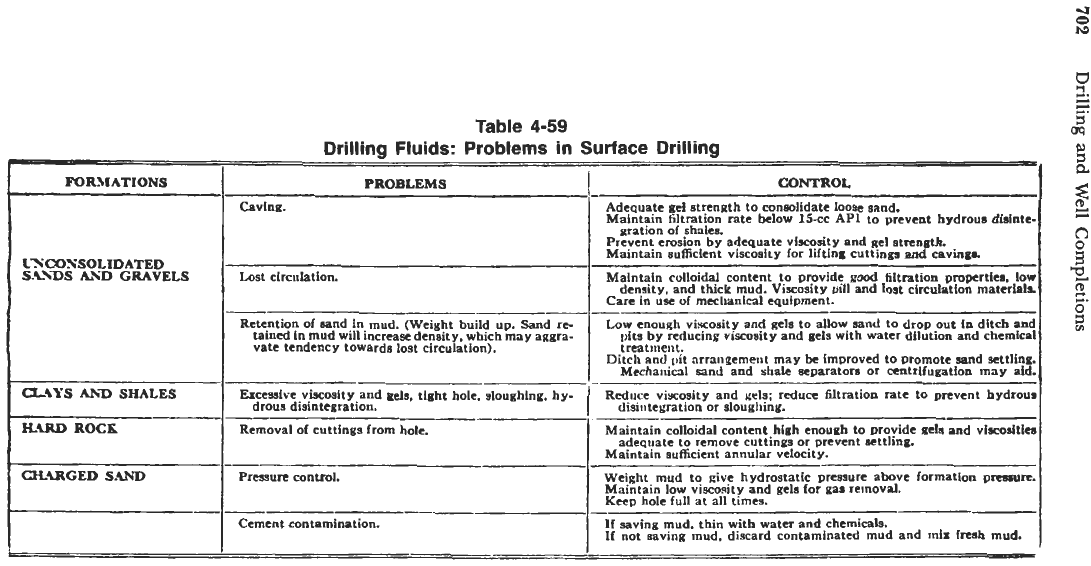
WRIIATIONS
I
CSCOXSOLIDATED
S.L.DS
ILKD
GRAVELS
€Lm
ROCK
Table
4-59
Drilling Fluids:
Problems
in Surface Drilling
-cI
-
PROBLEMS
Caving-
Lost
circulation.
---.____-__
Retention
of
sand
In
mud. (Weight build
UP.
Sand
re-
tained in mud will increase density, which may aggra-
vate tendency towards
lost
circulation).
E.asaive viscosity and
gels,
tight hole. sloughing. hy-
drous disintegration.
Removal of cuttings from hole.
Pmum
control.
Cement contamination.
CONTROL
Adequate
gel
strcnnth
to
consolidate
loose
and.
Maintain filtration rate below 15-cc API
to
prevent hydrous dislnte-
Prevent erosion by adequate vidty and
pel
strength
Maintain sufficient viscosity
for
lifting cuttines
d
caving&
sation
of
shales.
I
Maintain colloidal content to provide
good
tiltrafion
prapertk..
low
density. and thick mud. Viscosity
wll
and lost circulation materials.
Care in
usc
of
meehmlcal tauipment.
Low enouah viscosity and
gels
to
allow
sad
to
drop
out
in
ditch
and
{,its by reducinp viscosity and
gels
with water dilution and chemical
treatinent.
Ditch
and
pit arrangement may
be
improved to promote and settling.
Mechaiiical
sand
and shale separators
or
centrifugation may aid.
Reduce vivcosity and
r*ls:
reduce
filtration
rate
to
pmvent hydrous
disiutegration
or
slougliiny.
Maintain colloidal content high enough
to
pmyide
gela
md vidtfes
Maintain sufficient annular velocity.
Weight mud
to
pive hydrostatic pressure above formation
RrraUrC.
Maintain
low
visco.4ty and gels
for
gar
removal.
Keep
hole
full
at
all times.
If
saving mud. thin with
water
and chemicals.
If not saving mud. discard contaminated mud and mix fresh mud.
adeqiiate to remove cuttings
or
prevent
settling.
-
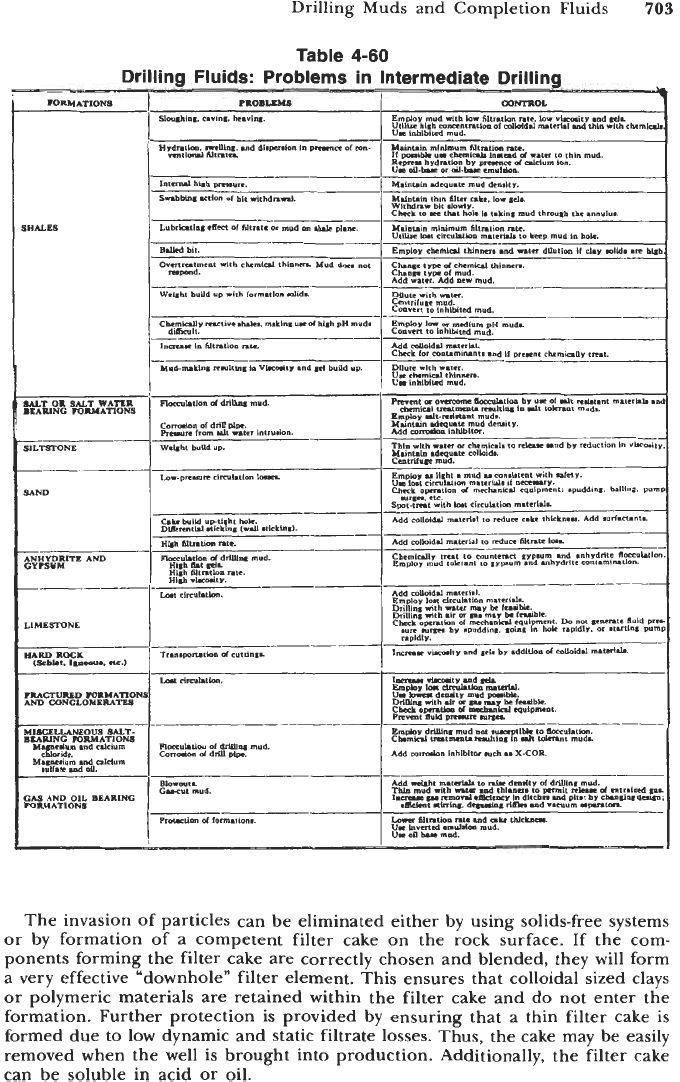
Drilling Muds and Completion Fluids
703
Table
4-60
Drillina Fluids: Problems in Intermediate Drillina
SHALES
MLT
OR
SALT
WATER
BEARING FOlMATlONS
______
SILTSTONE
SAND
ANHYDRITE
AND
GYPSUM
~ ~~
?RACTUIED FORMATION2
AND
CONGLOMERATES
GAS
AND
OIL
BEARING
FORMATION8
Loy
drruhlloa.
The invasion of particles can be eliminated either by using solids-free systems
or by formation of a competent filter cake on the rock surface.
If
the com-
ponents forming the filter cake are correctly chosen and blended, they will form
a very effective "downhole" filter element.
This
ensures that colloidal sized clays
or polymeric materials are retained within the filter cake and do not enter the
formation. Further protection is provided by ensuring that a thin filter cake
is
formed due to low dynamic and static filtrate losses. Thus, the cake may be easily
removed when the well is brought into production. Additionally, the filter cake
can be soluble in acid or oil.
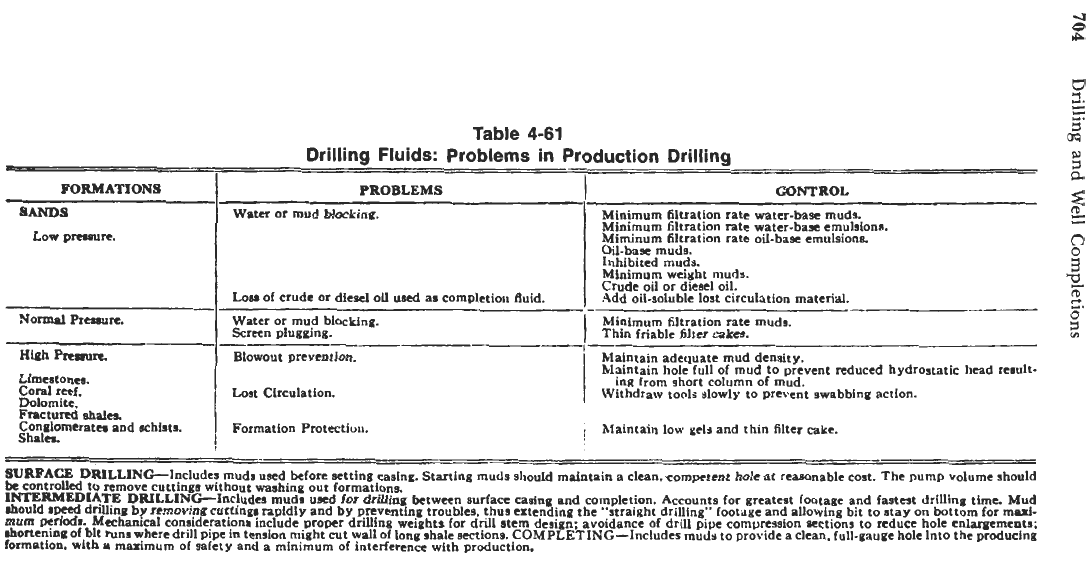
P
FORMATIONS
SANDS
Low
pmrurr.
Normal
Pmurc.
Hroh
pnmrr.
Llmeatoncn.
Coral
ref.
Dolomite.
Fractured
shalea
Conglomeratn and whlsts.
Shale..
--
s
a
CONTROL
Minimum filtration
rate
water-base muds.
Minimum filtration rate water-base emulsionr.
Miminum filtration rate oil-bar emulsions.
Oil-bar
muds.
Inhibited muds.
Minimum weight
muds.
Crude oil
or
diesel oil:
Add oil-soluble
lost
circulation material.
Minimum filtration rate muds.
1
Thin friable filter cakes.
Maintain adequate mud density.
Maintain hole full
of
mud
to
prevent reduced hydrostatic head rerult-
inR from short column
of
mud.
Withdraw tools slowly to prevent swabbing action.
Maintain
loa
gels
and thin filter cake.
PROBLEMS
Water
or
mud Mockins.
--
Losr
of
crude or diesel
oil
used
aa
completioir fluid.
Water
or
mud blocking.
Screen
plugging.
Blowout prevention.
Lost
Circulation.
Formation Protstioli.
;
i-
------
Q
2
L
